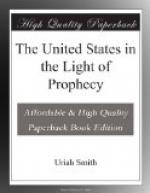The worship of the beast and his image, and the reception of his mark, must be something that involves the greatest offense that can be committed against God, to call down so severe a denunciation of wrath against it. This is a work, as was shown in chapter 4, which takes place in the last days; and as God has given us in his word most abundant evidence to show when we are in the last days, so that no one need to be overtaken by the day of the Lord as by a thief, so likewise it must be that he has given us the means whereby we may determine what this great latter-day sin is which he has so strongly condemned, that we may avoid the fearful penalty so sure to follow its commission. God does not so trifle with human hopes and human destinies as to denounce a most fearful doom against a certain sin, and then place it out of our power to understand what that sin is, so that we have no means of guarding against it.
That we are now living in the last days, the volumes both of revelation and nature bear ample and harmonious testimony. Evidence on this point we need not here stop to introduce; for the testimony already presented in the foregoing chapters of this series, showing that the two-horned beast is now on the stage of action, is in itself conclusive proof of this great fact, inasmuch as the power exists and performs its work in the very closing period of human history. All these things tell us that the time has now come for the proclamation of the third message of Rev. 14, to be given, and for men to understand the terms which it uses, and the warning it gives.
We therefore now call attention to the very important inquiry, What constitutes the mark of the beast? The figure of a mark is borrowed from an ancient custom. Says Bp. Newton (Dissert on Proph., vol. iii, p. 241):—
“It was customary among the ancients for servants to receive the mark of their master, and soldiers of their general, and those who were devoted to any particular deity, of the particular deity to whom they were devoted. These marks were usually impressed on their right hand, or on their foreheads, and consisted of some hieroglyphic character, or of the name expressed in vulgar letters, or of the name disguised in numerical letters according to the fancy of the imposer.”
Prideaux says that Ptolemy Philopater ordered all the Jews who applied to be enrolled as citizens of Alexandria to have the form of an ivy leaf (the badge of his god, Bacchus) impressed upon them with a hot iron, under pain of death. (Connection B.C. 216.)
The word used for mark in this prophecy is [Greek: charagma] (charagma), and is defined to mean, “a graving, sculpture, a mark cut in or stamped.” It occurs nine times in the New Testament, and with the single exception of Acts 17:29, refers every time to the mark of the beast. We are not, of course, to understand in this symbolic prophecy, that a literal mark is intended; but the giving of the literal mark,




